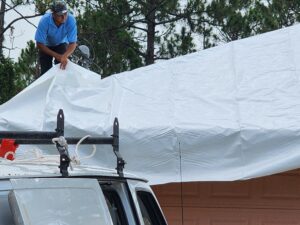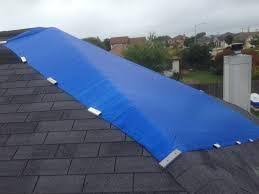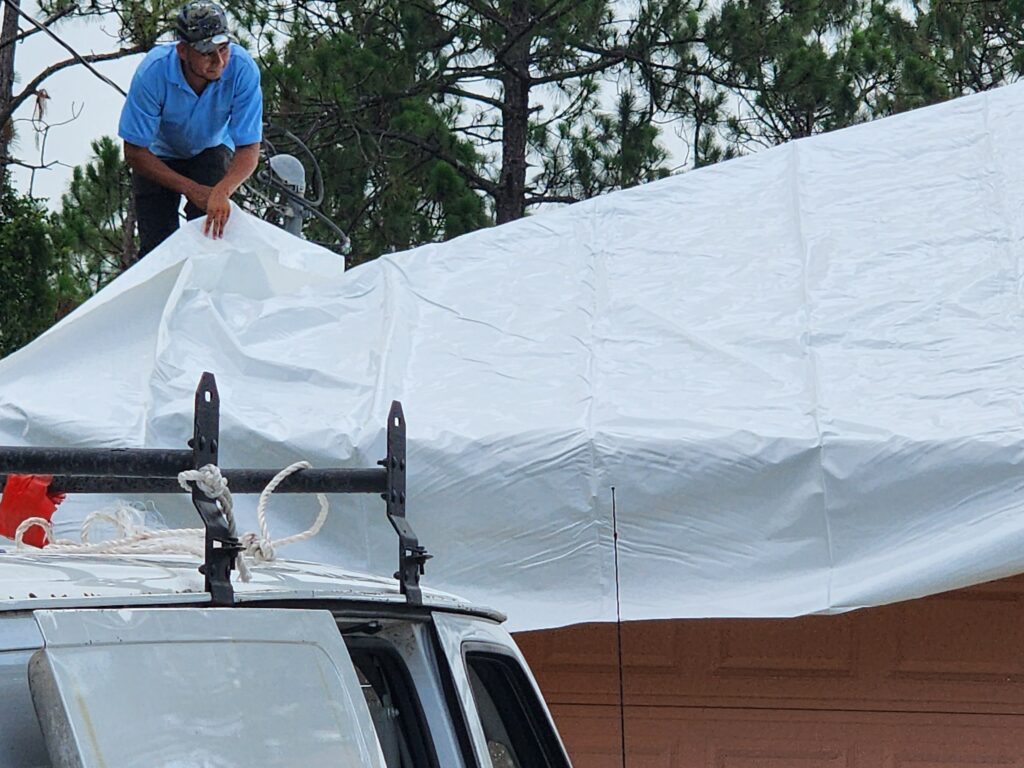blue Tarps and Shrink Wraps :
In the face of unpredictable weather and during construction or renovation projects, protecting your property becomes paramount. Two of the most effective methods for property protection are the use of tarps and shrink wraps. These simple yet powerful tools can provide a robust shield for your property, mitigating potential damage and saving you from costly repairs.
Tarp: The Versatile Protector
A tarp, or tarpaulin, is a large sheet made of flexible, water-resistant or waterproof material. It’s often reinforced with grommets at the corners and along the sides to enable it to be tied down or suspended.
Tarps are incredibly versatile. They can cover roofs damaged by storms, preventing water intrusion until repairs can be made. They’re also excellent for protecting machinery, building materials, and other items stored outdoors. When used correctly, a tarp can save homeowners a significant amount of money in potential water damage.
Shrink Wrap: The Custom Shield
Shrink wrap, on the other hand, is a plastic film that you can wrap around any object, no matter its size or shape. When heat is applied, it shrinks tightly over whatever it’s covering.
Shrink wrap is perfect for protecting items during transportation or storage. It can keep dust, debris, and moisture away from your belongings, making it particularly useful during home renovations or when storing items for extended periods. It’s also commonly used in the construction industry to create temporary containment structures, protecting the work environment from the elements and containing dust or debris.
Conclusion
Whether you’re dealing with a leaky roof, undergoing a home renovation, or simply storing items, tarps and shrink wraps are essential tools for protecting your property. They offer a cost-effective solution to prevent damage and extend the lifespan of your belongings. Remember, it’s always better to prevent damage than to deal with the aftermath. So, don’t underestimate the importance of these protective measures.✨


✨Sure, here are the answers to your questions:
What are the different types of tarps available and how do they differ in their uses?
There are several types of tarps including poly tarps, canvas tarps, mesh tarps, and vinyl tarps. Poly tarps are lightweight, waterproof, and affordable, making them suitable for general purposes. Canvas tarps are heavier and more durable, ideal for industrial applications. Mesh tarps are designed to allow air flow, making them perfect for shading purposes. Vinyl tarps are the most durable and are resistant to oil, acid, grease, and mildew, making them suitable for heavy-duty applications.
How do you properly secure a tarp to ensure maximum protection?
To secure a tarp, you should first spread it out evenly over the area you want to cover. Then, use ropes, bungee cords, or tarp straps to tie the tarp down through its grommets. For added security, you can place weights or sandbags on the edges of the tarp.
What factors should you consider when choosing a tarp for your specific needs?
When choosing a tarp, consider its material, size, durability, and the specific requirements of your project. For instance, if you need a tarp for a roofing project, you’d want a heavy-duty, waterproof tarp. If you’re using it to cover a truck bed, a mesh tarp might be more appropriate to allow air flow.
How can tarps be used to protect a roof after storm damage?
After a storm, a tarp can be used to cover damaged areas of a roof to prevent water intrusion and further damage. The tarp should be secured with ropes or straps to ensure it stays in place until repairs can be made.
What are the benefits of using tarps during a construction project?
Tarps can protect construction materials and equipment from weather elements, dust, and debris. They can also be used to create a barrier for dust control, or to cover open structures during construction.


How do you maintain and clean a tarp to ensure its longevity?
Tarps should be cleaned with mild soap and water and allowed to dry completely before storage to prevent mold and mildew. Avoid using harsh chemicals that could degrade the tarp material. Store your tarp in a cool, dry place.
What are the safety precautions to keep in mind when using a tarp?
When using a tarp, ensure it’s securely fastened to prevent it from blowing away and causing injury or damage. If using a tarp to cover a load on a vehicle, make sure it’s secure and doesn’t obstruct the driver’s view. Always check for wear and tear before using a tarp.
How can tarps be used in emergency situations?
In emergencies, tarps can be used to create temporary shelters, collect rainwater, cover broken windows, or as a ground cover. They’re a versatile tool in any emergency kit.
What are some common mistakes to avoid when using tarps?
Common mistakes include choosing the wrong type or size of tarp for the job, not securing the tarp properly, and not checking the tarp regularly for wear and tear.
Can tarps be used for purposes other than protection, such as for creating shade or a makeshift shelter?
Absolutely! Tarps are incredibly versatile. They can be used to create shade, as a ground cover for camping, to make a makeshift shelter, or even as a privacy screen. The possibilities are endless.✨
Blue tarps, also known as blue poly tarps, are commonly used for a variety of reasons:
Affordability: Blue tarps are typically less expensive than tarps made from other materials, making them a cost-effective choice for many people.
Water Resistance: They are made from polyethylene, a type of plastic that is highly resistant to water, making them ideal for protecting against rain and other forms of moisture.
Versatility: Blue tarps are lightweight and easy to handle, yet durable enough for a variety of uses. They can be used for temporary roof repairs, as a cover for outdoor equipment, for camping, and more.
Visibility: The bright blue color of these tarps makes them highly visible, which can be useful in emergency situations or when you want to easily keep track of covered items.
UV Protection: Many blue tarps are treated to be UV resistant, which helps to prevent damage from the sun’s rays when used to cover items outdoors.
Remember, while blue tarps are versatile and useful in many situations, they are not designed for long-term use and may not be the best choice for certain applications where a more durable material is needed.✨
